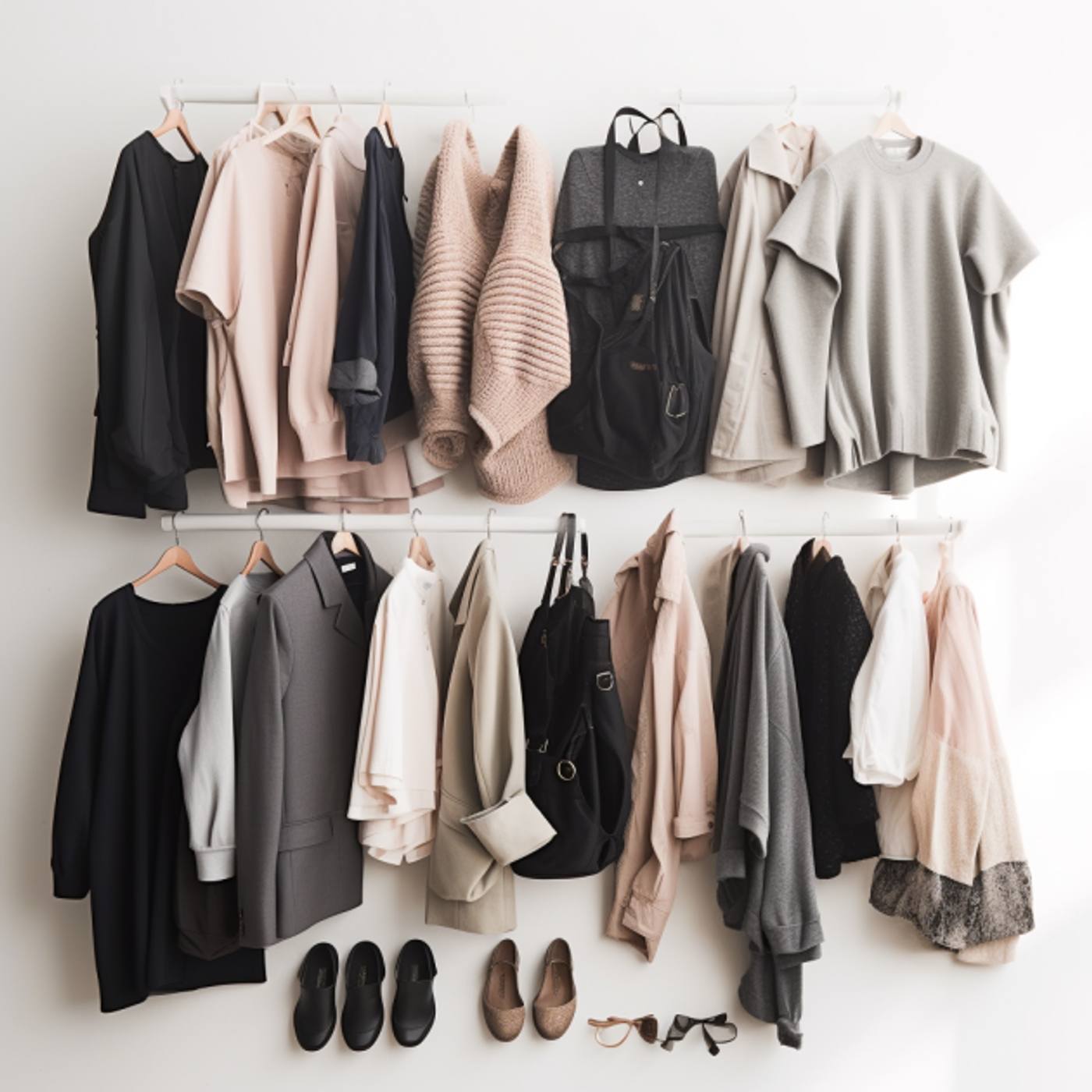FASHION
How To Create A Capsule Wardrobe In 2024
Published
7 months agoon
By
wpadminee
Creating a capsule wardrobe that truly reflects your style and meets your daily needs requires thoughtful planning and organization.
This guide will walk you through the essential steps to build a wardrobe that is both functional and stylish, ensuring you feel confident and comfortable in what you wear.
Follow these steps to achieve a capsule wardrobe that works for you.
Step 1: Assess Your Current Wardrobe
Before you can build a new wardrobe, it’s important to take stock of what you already have. Begin by thoroughly assessing your current wardrobe. Pull out all your clothes, shoes, and accessories, and lay them out where you can see everything.
Start by evaluating each item. Ask yourself if you still wear it, if it fits well, and if it aligns with your current lifestyle and personal style. Be honest with yourself—there’s no point in holding onto clothes that no longer serve you. This step will help you identify what you truly need and what gaps exist in your wardrobe.
Once you’ve sorted through everything, separate your items into three categories: keep, donate/sell, and discard. The “keep” pile should include only those pieces that you love, wear regularly, and feel confident in. Items that are in good condition but no longer suit you can be donated or sold, while worn-out or damaged items should be discarded.
Step 2: Define Your Personal Style
With a clearer idea of what you already own, it’s time to define your personal style. Your style is an expression of who you are, so it should reflect your personality, lifestyle, and preferences.
Start by gathering inspiration. Look through magazines, social media, and fashion blogs to identify styles, colours, and silhouettes that resonate with you. Pay attention to recurring themes—do you gravitate toward classic, minimalist looks, or are you more drawn to bold, eclectic styles? Create a mood board or a Pinterest board to visually capture your style inspirations.
Next, think about your daily activities and the environments you spend time in. Your wardrobe should be practical and versatile, catering to both your professional and personal life. For example, if you work in a corporate setting, you might prioritize tailored pieces and neutral colours, while someone with a more casual lifestyle might focus on comfortable, easy-to-wear items.
Finally, consider how you want to feel in your clothes. Whether it’s polished, relaxed, edgy, or feminine, your wardrobe should make you feel confident and true to yourself.
Step 3: Choose a Color Palette
A cohesive colour palette is key to a versatile and easily mixable wardrobe. Start by identifying your favourite colours—those you naturally gravitate towards and feel good wearing. Then, consider neutral colours like black, white, grey, navy, and beige, which can form the foundation of your wardrobe and easily pair with other colours.
Aim to select three to five core colours that will serve as the base of your wardrobe. These should be versatile and flattering on you. Then, choose a few accent colours to add variety and personality. These can be brighter or more unique shades that complement your core colours.
By sticking to a defined colour palette, you’ll find it easier to mix and match pieces, ensuring that everything in your wardrobe works together seamlessly.

Step 4: Identify Your Core Pieces
Core pieces are the foundation of your wardrobe—items that you can wear in multiple settings and style in different ways. These are usually classic, versatile pieces that never go out of style.
Some examples of core pieces include well-fitted jeans, a classic white shirt, a tailored blazer, and a little black dress. The exact core pieces you need will depend on your lifestyle and personal style. For instance, if you work in an office, you might prioritize dress pants and blouses, while someone with a more casual lifestyle might focus on quality t-shirts and knitwear.
Invest in high-quality core pieces, as these will be the workhorses of your wardrobe. Choose items made from durable fabrics that fit well and flatter your body shape.
Step 5: Add Accent Pieces
Once you’ve established your core pieces, it’s time to add accent pieces. These are items that add personality and variety to your wardrobe, such as statement tops, patterned skirts, or unique accessories. Accent pieces allow you to experiment with trends and express your individuality without compromising the versatility of your wardrobe.
When choosing accent pieces, consider your colour palette and how each item will pair with your core pieces. This ensures that even your more unique items can be easily incorporated into different outfits.
Step 6: Mix and Match
With your core and accent pieces in place, the next step is to mix and match to create a variety of outfits. The goal is to maximize the versatility of your wardrobe by finding new and creative ways to wear your clothes.
Experiment with layering, pairing different textures, and combining colours from your palette. Don’t be afraid to step out of your comfort zone and try new combinations. The more you practice mixing and matching, the more confident you’ll become in your styling abilities.
Creating a capsule wardrobe—where every piece can be worn together—can be a great way to streamline your wardrobe and ensure that everything you own works well together.
Step 7: Maintain and Refresh
Building a wardrobe is not a one-time task; it requires ongoing maintenance and occasional refreshing. Regularly assess your wardrobe to ensure that it still meets your needs and reflects your style. At the end of each season, take some time to evaluate your clothes and decide if any items need to be replaced, repaired, or donated.
Stay open to evolving your style. As your life changes, so too will your wardrobe needs. Don’t hesitate to update your wardrobe with new pieces that reflect your current lifestyle and preferences.
By following these steps, you can create a capsule wardrobe that is both stylish and functional, tailored to your unique taste and lifestyle.
For more updates on fashion, visit here.
You may like
-


How To Style A Jean Jacket According To Denim Experts
-


Take A Look At Osas Ighodaro’s Glamorous Gala Look
-


6 Wardrobe Essentials Every Professional Woman Should Own
-


5 Fashion Mistakes Men Make That Women Find Unattractive
-


Skepta Graced Africa International Film Festival (AFRIFF) In Elegant Trad
-


How The Speedy Bag Became A New Menswear Favourite
FASHION
Cobhams Asuquo’s Birthday Look Exudes Cinematic Vibe
Published
3 months agoon
January 6, 2025By
Reporter
Acclaimed Nigerian musician, producer, and songwriter Cobhams Asuquo has marked his 44th birthday with a striking professional photoshoot that showcases his bold fashion choices and artistic vision.
The celebrated artist selected an elegant ensemble featuring a dramatic, floor-length black robe, which has been thoughtfully embellished with vibrant, multicoloured fringe detailing along the hemline, wrist cuffs, and shoulder areas.
To complement this regal attire, Asuquo incorporated sophisticated accessories. This includes a well-crafted black hat, refined dark sunglasses, and carefully selected silver jewellery pieces.
The look creates a cohesive look that reflects both sophistication and artistic flair. The overall aesthetic of his birthday photographs evokes a cinematic quality, demonstrating his keen eye for visual presentation alongside his well-known musical talents.
Asuquo, who has garnered significant recognition for his work on notable soundtracks including “Everybody Loves Jenifa” and the festive romantic comedy “Christmas in Lagos,” shared these photographs on social media with a characteristically engaging message.
His caption, written in Nigerian Pidgin English, expressed optimistic sentiments about the year ahead, stating, “Year wey go sweet na January 6 we dey know. Happy birthday to me.”
The birthday photoshoot stands as a testament to Asuquo’s multifaceted artistic expression, seamlessly blending musical accomplishment with visual creativity.
His choice of attire and styling demonstrates a sophisticated understanding of fashion as a medium for personal expression, while the professional quality of the photographs underscores his commitment to excellence across all creative endeavours.
See the photos below.
Check out more fashion updates here.
FASHION
4 Ways You Can Slay This Christmas Season
Published
3 months agoon
December 22, 2024By
wpadminee
The Christmas season bursts with joy, love, and celebration, making it the perfect time to slay your unique style and make a statement.
From dazzling holiday parties to cosy family gatherings and magical moments spent soaking in the festive atmosphere, this time of year offers countless opportunities to stand out and showcase your personal flair.
Whether you’re dressing to impress at a glamorous event or keeping it chic for an intimate get-together, embracing the spirit of the season through your fashion choices is a fantastic way to shine.
To help you slay this Christmas season with confidence and style, here are four practical and inspiring tips:
1. Elevate Your Holiday Wardrobe
One of the easiest ways to slay this Christmas season is to elevate your holiday wardrobe. Invest in a few key pieces that can be mixed and matched to create different looks. A festive sweater, a sparkly dress, or a stylish pair of boots can instantly elevate your outfit.
Don’t be afraid to experiment with colours, patterns, and textures. A bold red dress, a plaid skirt, or a velvet blazer can add a touch of holiday cheer to your look.
Remember, the key to slaying this Christmas season is to feel confident and comfortable in what you’re wearing. When you feel good, you look good.
2. Embrace Festive Makeup
Makeup is a great way to enhance your natural beauty and add a touch of holiday glamour. Experiment with bold lips, shimmery eyeshadow, and dramatic eyeliner.
A classic red lip is a timeless choice for the holidays. It’s bold, and elegant, and can instantly elevate any outfit.
If you’re feeling adventurous, try a smoky eye or a colourful eyeliner. These looks are perfect for a holiday party or a night out.
Don’t forget about your skin! A flawless complexion is the foundation of any great makeup look. Use a hydrating moisturiser, a primer, and a long-lasting foundation to create a smooth, even canvas.
3. Accessorise with Holiday Cheer
Accessories are the perfect way to add a touch of personality to your holiday look. A statement necklace, a pair of sparkly earrings, or a festive hair accessory can instantly elevate your outfit.
Don’t be afraid to mix and match different accessories. A bold necklace, a delicate bracelet, and a pair of statement earrings can create a stunning look.
Remember, the key to slaying this Christmas season is to have fun with your accessories. Experiment with different styles and colours to find what works best for you.
4. Nail the Holiday Hair
Your hair is an important part of your overall look. A stylish hairstyle can complete your outfit and help you slay this Christmas season.
A classic updo, a sleek ponytail, or loose waves are all great options for the holidays. If you’re feeling adventurous, try a festive hair accessory, like a sparkly headband or a pair of reindeer antlers.
Remember, the key to slaying this Christmas season is to choose a hairstyle that suits your face shape and personal style.
By following these four tips, you can slay this Christmas season. Remember, the most important thing is to have fun and express your personal style.
For more fashion tips, check here.
FASHION
How To Style A Jean Jacket According To Denim Experts
Published
4 months agoon
December 8, 2024By
wpadminee
How to style a jean jacket becomes an art form when you understand the versatility of this timeless piece.
Denim experts are ready to rescue your forgotten jean jackets from the depths of your closet. They’ve curated a collection of foolproof styling strategies that will reignite your passion for this wardrobe staple.
The classic denim jacket transcends fleeting fashion trends, offering endless styling possibilities for every aesthetic. Fashion stylists emphasise that understanding how to style a jean jacket can transform your entire wardrobe approach.
Whether you’re aiming for a casual streetwear look, an edgy urban ensemble, or a sophisticated layered outfit, the denim jacket serves as your ultimate fashion chameleon.
Seasoned fashion professionals reveal that mastering how to style a jean jacket requires a blend of creativity and strategic layering.
They recommend experimenting with unexpected pairings: combine a vintage wash denim jacket with tailored trousers, or layer a cropped version over a delicate silk dress for maximum style impact.
Denim experts unanimously agree that the key is to break traditional rules, mix textures, and let your individual personality shine through this versatile wardrobe essential.
How to Style a Jean Jacket: A Denim Expert’s Guide
The jean jacket is a timeless classic that never goes out of style. Whether you’re looking for a casual, edgy, or sophisticated look, a denim jacket can elevate any outfit.
But how to style a jean jacket? In this guide, we’ll share some expert tips on how to style a jean jacket to create various looks.
1. Classic Casual
A classic way to style a jean jacket is to pair it with jeans. When you style a jean jacket like this, it gives a timeless look that’s both comfortable and stylish.
You can opt for a light wash denim jacket with dark wash jeans or vice versa. Add a simple white t-shirt and sneakers to complete the look.
2. Edgy and Cool

To achieve an edgy look, pair your denim jacket with leather pants or a leather skirt. This style is perfect for a night out or a music festival. You can also add a graphic tee or a band t-shirt to complete the look.
3. Feminine and Chic
To create a feminine and chic look, pair your denim jacket with a floral dress or a skirt. With this look, it is perfect for a brunch date or a casual day out. You can also add a pair of heels or boots to elevate the look.
4. Layering Magic
Layering is a great way to style a jean jacket. This can create a stylish and cosy look. You can layer it over a sweater, a hoodie, or a flannel shirt.
5. Accessorise, Accessorise, Accessorise
Accessories can elevate any outfit, including one with a denim jacket. This can add a personal touch to your look. You can add a scarf, a hat, or a pair of sunglasses.
6. Colour Blocking
Colour blocking is a great way to add a pop of colour to your outfit. If you know how to style a jean jacket like this, it can create a bold and stylish look. You can pair your denim jacket with a brightly coloured top or bottom.
7. Denim on Denim

Denim on denim is a classic look that can be both stylish and comfortable. Like this, it can be a bit tricky, but with the right styling, you can pull it off. The key is to choose different shades of denim.
8. The Oversized Look
Oversized denim jackets are trendy and comfortable. Create a relaxed and effortless look with this style. You can pair it with leggings, jeans, or a skirt.
9. The Belted Look
Belting your denim jacket is a great way to cinch your waist and create a more flattering silhouette. This can be a stylish and practical way to wear your denim jacket.
10. The Layered Look

Layering your denim jacket over a dress is a great way to add a casual touch to a feminine look. This can create a stylish and versatile outfit.
The most important thing is to experiment and find what works best for you. With a little creativity, you can create countless stylish looks with a denim jacket.
For more fashion tips, visit here.
Latest


Samsung Galaxy S25 Series Sets The Standard Of AI Phones As A True AI Companion
Samsung Galaxy S25 series sets the standard of AI phones as a true AI companion …Pioneering the multimodal era with...


5 Things To Expect In Afrobeats In 2025
Afrobeats is poised to reach unprecedented heights in 2025 as Nigerian music continues its remarkable global ascent. The genre’s explosive...


Here Are The 7 Most Ancient Countries On Earth
The oldest countries in the world stand as remarkable testaments to human civilisation, each containing landscapes and monuments that narrate...


Why Self-Reflection Is More Important Than Resolutions
Millions of people embark on a yearly ritual: they sit down with a notebook and pen, eager to craft a...


Nollywood Director, Kemi Adetiba Teases King Of Boys 3
Nollywood director Kemi Adetiba has revealed that another instalment of King of Boys will be released on December 25, 2025....


John McEnroe Says He Can Be The Commissioner Tennis Needs Amid Doping Crisis
Recent doping controversies involving top players have not damaged tennis’s reputation, but John McEnroe believes that appointing a single commissioner...


“Everybody Loves Jenifa” Becomes Nollywood’s Highest-Grossing Film Of All Time
Nollywood filmmaker Funke Akindele has achieved a historic milestone with her latest film, “Everybody Loves Jenifa.” The film has officially...


FG To Premiere TV Series, “Hidden Riches” On Mining Sector On January 25
Nigeria’s Federal Government will launch an ambitious television drama series focused on the nation’s mining sector, premiering “Hidden Riches” on...


Qing Madi Delivers A Soulful Performance Of “Favourite Pyscho”
Rising Afro-RnB sensation Qing Madi launches into 2025 with a mesmerising performance on the prestigious COLOURS platform, showcasing her latest...


Taiwo Awoniyi’s First Goal Of The Season Seals Nottingham Forest’s Win Over Wolves
Taiwo Awoniyi made a triumphant return to Premier League action. He scored in stoppage time to help Nottingham Forest crush...
-Ad-




